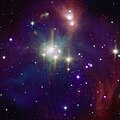ファイル:Coronet Cluster- A Neighbor of Star Formation (A region of star formation about 420 light years from Earth.) (2940634813).jpg

元のファイル (3,300 × 3,300 ピクセル、ファイルサイズ: 1.09メガバイト、MIME タイプ: image/jpeg)
ウィキメディア・コモンズのファイルページにある説明を、以下に表示します。
|
概要
| 解説Coronet Cluster- A Neighbor of Star Formation (A region of star formation about 420 light years from Earth.) (2940634813).jpg |
Description: The Corona Australis region is one of the nearest and most active regions of ongoing star formation in our Galaxy. At only 420 light years away, the Coronet is 3.5 times closer than the Orion Nebula Cluster. The Coronet contains a loose cluster of a few dozen known young stars with a wide range of masses at various stages of evolution. The central area of the star-forming region contains the densest clustering of very young stars, embedded in dust and gas. This composite image shows the Coronet in X-rays (Chandra, purple) and infrared emission (Spitzer, orange, green, and cyan). By studying the variability in different energies, scientists hope to better understand the evolution of very young stars. Creator/Photographer: Chandra X-ray Observatory NASA's Chandra X-ray Observatory, which was launched and deployed by Space Shuttle Columbia on July 23, 1999, is the most sophisticated X-ray observatory built to date. The mirrors on Chandra are the largest, most precisely shaped and aligned, and smoothest mirrors ever constructed. Chandra is helping scientists better understand the hot, turbulent regions of space and answer fundamental questions about origin, evolution, and destiny of the Universe. The images Chandra makes are twenty-five times sharper than the best previous X-ray telescope. NASA's Marshall Space Flight Center in Huntsville, Ala., manages the Chandra program for NASA's Science Mission Directorate in Washington. The Smithsonian Astrophysical Observatory controls Chandra science and flight operations from the Chandra X-ray Center in Cambridge, Massachusetts. Medium: Chandra telescope x-ray Date: c. 2000 Persistent URL: chandra.harvard.edu/photo/2007/coronet/ Repository: Smithsonian Astrophysical Observatory Collection: X-rays Collection - X-rays are electromagnetic radiations beyond ultra-violet which form a shadow image of the internal structure of the object when passed through a solid object and allowed to act upon a sensitive emulsion. Gift line: X-ray: NASA/CXC/CfA/J.Forbrich et al.; Infrared: NASA/SSC/CfA/IRAC GTO TeamAccession number: Coronet |
| 日付 | |
| 原典 | Coronet Cluster: A Neighbor of Star Formation (A region of star formation about 420 light years from Earth.) |
| 作者 | Smithsonian Institution from United States |
| 許可 (ファイルの再利用) |
Smithsonian Institution @ Flickr Commons |
ライセンス
この画像はFlickrのThe Commonsから提供されています。Flickrにアップロードした組織は次のような理由などから「著作権上の制限無し」と分類することがあります。 No known copyright restrictionsNo restrictionshttps://www.flickr.com/commons/usage/false
詳しい情報は https://flickr.com/commons/usage/ をご覧ください。 著作権の状態について明確な情報を決定できる場合は更なる著作権タグを追加してください。詳しくはCommons:ライセンシングをご覧ください。 |
| この画像は当初、Smithsonian Institution によって Flickr の https://flickr.com/photos/25053835@N03/2940634813 に投稿されたものです。2016-09-14、FlickreviewR ボットによってレビューされ、No known copyright restrictions のライセンスで提供されていることが確認されました。 |
2016年9月14日
キャプション
このファイルに描写されている項目
題材
ウィキデータ項目がない値
30 9 2008
image/jpeg
94c977a12eba603337a4cfb46414d84950f334d2
1,144,364 バイト
3,300 ピクセル
3,300 ピクセル
ファイルの履歴
過去の版のファイルを表示するには、その版の日時をクリックしてください。
| 日付と時刻 | サムネイル | 寸法 | 利用者 | コメント | |
|---|---|---|---|---|---|
| 現在の版 | 2016年9月14日 (水) 07:37 |  | 3,300 × 3,300 (1.09メガバイト) | Vanished Account Byeznhpyxeuztibuo | Transferred from Flickr via Flickr2Commons |
ファイルの使用状況
以下のページがこのファイルを使用しています:
メタデータ
このファイルには、追加情報があります (おそらく、作成やデジタル化する際に使用したデジタルカメラやスキャナーが追加したものです)。
このファイルが元の状態から変更されている場合、修正されたファイルを完全に反映していない項目がある場合があります。
| 画像の説明 |
|
|---|---|
| 作者 | Chandra X-ray Observatory Center |
| 撮影著作権者/編集著作権者 | http://chandra.harvard.edu/photo/image_use.html |
| 帰属/提供者 | X-ray: NASA/CXC/CfA/J.Forbrich et al.; Infrared: NASA/SSC/CfA/IRAC GTO Team |
| ソース | Chandra X-ray Observatory |
| 見出し | A region of star formation about 420 light years from Earth. |
| オンライン上の著作権文 | |
| 使用条件 | |
| 原画像データの生成日時 | 2007年9月13日 (木) |
| 画像の幅 | 3,300 ピクセル |
| 画像の高さ | 3,300 ピクセル |
| 画像のビットの深さ |
|
| 圧縮の種類 | LZW |
| 画素構成 | RGB |
| 画像方向 | 通常 |
| コンポーネント数 | 3 |
| 水平方向の解像度 | 300dpi |
| 垂直方向の解像度 | 300dpi |
| 画像データの並び | 点順次フォーマット |
| 使用ソフトウェア名 | Adobe Photoshop CS3 Macintosh |
| ファイル変更日時 | 2008年9月30日 (火) 10:29 |
| 色空間情報 | その他 |
| 実効画像の幅 | 3,300 ピクセル |
| 実効画像の高さ | 3,300 ピクセル |
| Exifバージョン | 2.21 |
| デジタルデータの作成日時 | 2008年9月30日 (火) 06:29 |
| メタデータの最終更新日 | 2008年10月8日 (水) 14:39 |
| キーワード | Coronet Cluster |
| 連絡先情報 | cxcpub@cfa.harvard.edu
60 Garden St. Cambridge, MA, 02138 USA |
| IIMバージョン | 2 |
